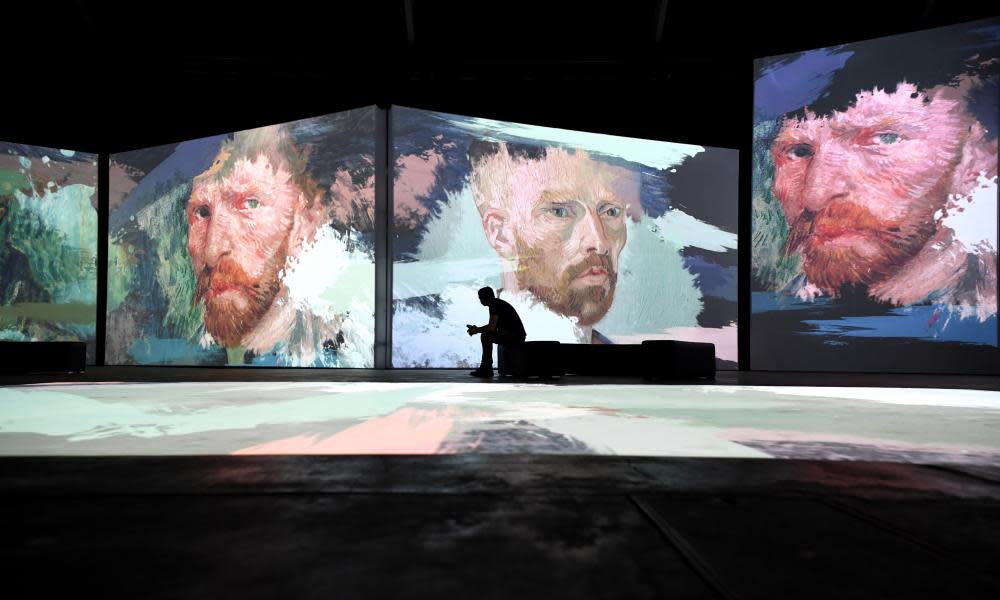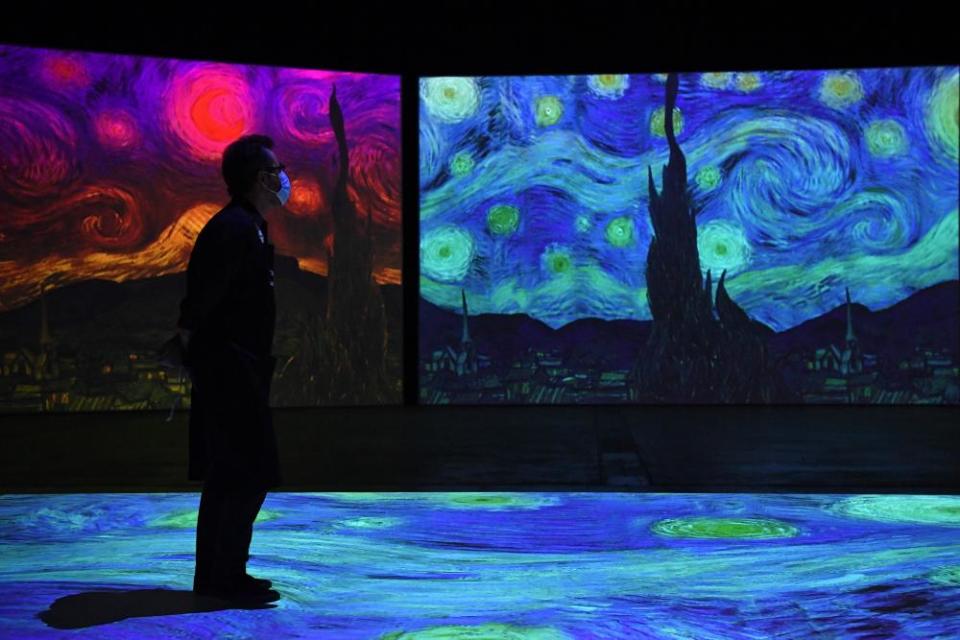Van Gogh Alive! review – resurrecting the dead in a glossy, impersonal blockbuster

Isn’t it strange how the future has ended up looking so much like the past?
For all the technical wizardry that allows us to literally resurrect the dead, albeit in faint simulacra of their original selves, we’re still prone to creating things in forms that aren’t that much different to what you might have experienced 150 years ago.
The just-opened Van Gogh Alive! at the Royal Hall of Industries, in Sydney’s Moore Park precinct (formerly Fox Studios) is a perfect example of this back-to-the-past-via-the-future effect.
Related: Place depicted in Van Gogh's final painting found with help of postcard
The event is essentially a walk-through sound and light show that projects Vincent Van Gogh’s works on to the walls and floors of the giant exhibition hall. The broken up, enlarged and sometimes computer-animated images of Van Gogh’s paintings are accompanied by sombre music and additional videos of flowers, period photos of Paris and outer space.
It’s all done semi-tastefully as it hangs its 45-minute run time on a loose biography of Van Gogh, heavy on the beauty and tragedy. It starts well, then gets sad, then the artist dies. But don’t be too sad – his reputation lives on, and happily his art now exists in the public domain. (Run corporate credits here.)
The show is the work of the Melbourne-based Grande Exhibitions, the company that has toured it around the world to more than 50 cities and 6 million visitors, and is the creator of Monet and Friends, The Leonardo da Vinci Collection, Alice – A Wonderland Adventure and Planet Shark: Predator or Prey.
No names are attached to the event – no writers or directors, no animators or other technical credits – so the event has an impersonal feel, a glossy corporate sheen that undercuts the seriousness of the subject, giving the overall experience an aesthetic that’s similar to walking through a shopping centre or airport.

But that’s OK, because Grande Exhibitions is on a mission. It wants to change the way we experience art by forgoing “all preconceived ideas of traditional museum visits, [and dispelling] all notions of tiptoeing through silent art galleries to view masterpieces from afar”. This, it says, allows adults and children to engage “with the experience in a manner that transcends traditional installations”.
The irony is that all of this has happened before. Around Europe in the late 19th century, enterprising entrepreneurs were thinking up ways to show art in non-traditional art environments, often including music, lighting and sound effects. In the late 1850s, a trio of massive paintings featuring apocalyptic imagery by the English painter John Martin were toured around the world in this manner, including in Australia, and drew an audience in the millions. And this is just one example – many such shows took place in Europe, the US and elsewhere.
The oddness of celebrating the life of a long dead painter is underscored by the semi-anonymity of the audience
What’s interesting is that as these kinds of experiences flourished, two things happened that would consign them to the sideshow.
The first was that the gallery experience that we now know so well – white walls, respectful silence, up close and personal engagement with a work of art – became the default way art is shown. While the traditional gallery context can be demanding, especially in blockbuster shows of masterpieces, one does at least have the chance to encounter the object made by an artist.
And the second thing that happened to the sound and light show was cinema. Theatrical extravaganzas around a static work of art were made redundant as the animating magic of the screen could produce an emotional experience in an audience like no other.
So, if anything, Van Gogh Alive! is very much a thing of the past.

Yet there are a few reasons that the show does speak to the present moment. One is Covid-19.
For Van Gogh Alive! steps have been taken to produce a show that aligns “perfectly with a post-pandemic world”. Visitors must wear masks, numbers are limited, and social distancing is encouraged.
Related: Dutch art detective says he has 'proof of life' of stolen Van Gogh painting
The oddness of celebrating the life of a long dead painter, who one cannot imagine could even conceive of the afterlife of his art in a temporary digital temple, is underscored by the semi-anonymity of the audience. People wander through in family groups, kids play, older folk sit on chairs – everyone with their phones out, snapping away.
And this is the most profound and slightly upsetting aspect of the show. It robs Van Gogh’s work of all its physical context, from the intimate scale of his canvases, and his incredible use of paint and texture, to the choice of subjects, so real and relatable, all of it becoming grist for the spectacle, images for Facebook and Instagram.
On a screen dedicated to text from Van Gogh’s own writing, a sentence pops up: “Someday death will take us to another star.”
Instead, death has taken Van Gogh’s art and his biography and made it the stuff of entertainment, and no matter how reverent or meaningful its makers might think it is, they’ve merely created a feed point from which his art endlessly circulates in the world system of social media, images disconnected from their maker, just another visual distraction alongside good doggos, funny cats, and Trump speeches.
Fortunately, perhaps, this a future Van Gogh could never have anticipated, but it’s the one that’s our reality.


